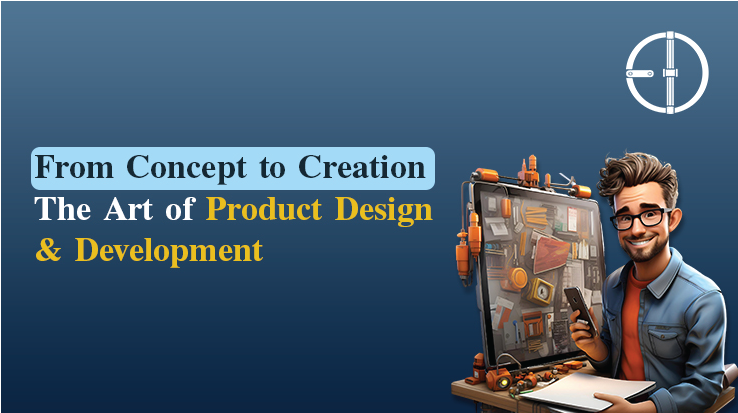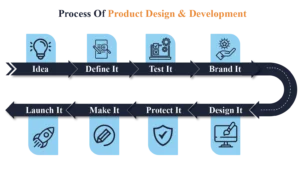
Introduction
In today’s presto-paced and invention-driven world, the trip from a simple idea to a completely functional product requires more than just creativity, it demands a structured, intelligent, and design-concentrated approach. This is where the art of product design and development comes into play.
At Eunoia Designtech, we believe that every groundbreaking product starts with an important conception and evolves through thoughtful design and engineering. Product design isn’t just about aesthetics, it’s about working on real-world problems, enhancing user experience, and increasing manufacturability—all while keeping costs and timelines in check.
Our process integrates conceptual creativity, artificial design, 3D modeling, prototyping, and manufacturing support into a flawless workflow that transforms bold ideas into palpable, request-ready results. Whether you are an incipient with a disruptive conception or an established brand aiming to optimize a living product, our platoon is equipped with the tools, gifts, and experience to bring your vision to life.
In this blog, we’ll take you through the intricate process of product design and development—from the first sketch to the final product-ready model—stressing the strategy, creativity, and engineering behind every successful product.
What is Product Design & Development?
Product design and development is a multi-stage process that involves creating, refining, and bringing a product to request. It encompasses both the creative conceptualization of a product’s form, function, and features (product design) and the practical preparation and manufacturing of that product (product development).
Product Design description Product design is the creative process of defining a product’s look, feel, and functionality. It involves understanding stoner requirements, creativity, prototyping, and iterative refinement.
Pivotal Aspects User-Centricity Focuses on understanding user conditions and pain points to produce a product that is desirable and easy to use. Aesthetics and Functionality Balances the visual appeal of the product with its usability and effectiveness. Feasibility Ensures the product can be really manufactured and brought to vend. The iterative process involves nonstop testing and refinement grounded on stakeholder feedback.
In substance, product design is a subset of product development. It’s the creative and strategic foundation upon which product development builds. Product design focuses on the “what” and “why” of a product, while product development focuses on the “how” and “when” of bringing that product to request.
In substance, digital product design and development is a dynamic field that combines creative design with specialized moxie to shape the digital world we interact with diurnally.
Why is Product Design Important for Business?
Product design has a strategic role to play in the success of a business. It’s more than aesthetics—good product design enhances functionality, improves user experience, lowers costs, and builds a strong brand. also is why it’s critical
- Drives customer Satisfaction and dedication Well-designed products are intuitive and simple to use and satisfy user conditions. Happy guests will return and refer the product to others. Design aligned with user prospects inspires trust and long-term dedication.
- Generates a Competitive Edge Good design differentiates companies from massed requests. Such features or looks can be distinctive ones that could come from a brand (e.g., Apple, Dyson). Good design often turns out to be a make-or-break sales factor.
- Boosts Marketability and Deals Visually appealing and functional products attract further attention. Good design increases perceived value, frequently allowing for advanced price points. It can lead to viral marketing through positive client reviews and word-of-mouth.
- Enhances Functionality and Usability Well-designed things work well and fix actual problems. Cuts stoner frustration, which results in lower returns or complaints. Enables products to work for a broader culture, including individuals with disabilities or special needs.
- Reduces product and functional Costs Design for manufacturability (DFM) makes products less expensive and simpler to make. Efficient material utilization and a streamlined corridor minimize waste and assembly complexity. Prevents costly redesigns or recalls by resolving implicit issues in advance in development.
Why is Product Development Important for Business?
Product development is a process of developing or refining a product to fulfill request specifications, solve client issues, and accomplish business goals. That’s why product development is crucial to any business
- Drives Business Growth New products open up new profit avenues. Companies can enter new requests or expand being bones. It increases the overall value and strength of the product portfolio.
- Addresses Shifting customer needs request change, and so does customer eventuality. Product development keeps your offerings applicable by addressing customer feedback and responding to request trends. Establishes brand trust if guests notice you’re enriching and enforcing.
- Develops Competitive Edge constant invention keeps your business in the lead. Exclusive aspects or a superior stoner experience can differentiate your brand. Being static permits competitors to capture your request share.
- Improves Profitability Well-developed products that solve real problems can command advanced prices. Development can lead to cost-effective designs, reducing product or material costs. Customization or added functionality constantly justifies ultraexpensive pricing.
- Improves customer dedication and Satisfaction Products that are innovative, functional, and well-designed ameliorate customer experience. Lowers the rate of return and post-sale complaints.
How Does Eunoia Designtech Work on Product Design & Development?
At Eunoia Designtech, we transfigure innovative generalities into request-ready products using a formal, cooperative, and design-centered process. Then there is a rundown of how we work
- Discovery & Research We start by learning about your vision, pretensions, and user requirements. Conduct request and contender analysis, probe target stoners, and use case scripts. Set product conditions and constraints. Identify openings and inventions. Infer things and figure out a solid base before moving on to design.
- Concept Creativity & Sketching: Our creative team explores multiple design directions through rapid-fire generality generation. Hand-drawn and digital sketches, mood boards, and visual relief Concept donations and client feedback Early design evidence thing Translate ideas into visual possibilities.
- 3D Modeling & CAD Creation After a direction has been named, we produce detailed 3D CAD models, exercising sedulity—standard tools. Mechanical and artificial design integration element positioning and fitment Ergonomics, boundaries, and tolerance Iterative modeling grounded on feedback objects induces accurate, producible digital models.
- Prototyping & Testing We transfigure virtual models into physical prototypes to validate form and function. 3D printing (FDM/SLA/SLS), CNC machining, or mock-ups Functional and appearance models Usability, continuity, and performance testing Design advances grounded on results. Catch excrescences beforehand and ensure stoner-centered design.
- Design for Manufacturing (DFM) We design for efficient, cost-effective products. Material procurement and selection guidance Parts reduction and assembly simplification Quality considerations and forbearance analysis Seller collaboration and product support ensure your product is ready for large-scale production.
How Does the Product Design & Development Process Work in Eunoia Designtech?

- Idea : This is the stage of the initial conception of something new, where a new product’s core idea or belief is conceived. Identify a need or request a problem. Communicate potential outcomes or progress estimates of fit and suitability. Make rough sketches or notes to daydream the idea.
- Define It : Easily define the product’s purpose, features, and stoner conditions. This step sets the direction for all design and development conditioning. Prepare a product demand document (PRD). Specify target followership, functions, and specialized constraints. Figure out pretensions, timeline, and budget.
- Test It : This stage involves early confirmation and exploration to test the conception before heavy investment. Conduct sonar exploration and request checks. figure mockups or early prototypes Get feedback from druggies, stakeholders, or investors and upgrade the conception grounded on input.
- Brand It : Create the brand identity for the product to make it resonate with the target request. create a name and signature and communicating Align product design with brand looks and values. Plan positioning and insulation in the request
- Design It : This step focuses on creating the look, feel, and stoner experience of the product. Develop artificial and mechanical design generalities. Use 3D modeling, CAD tools, and simulations. Prioritize usability, ergonomics, and aesthetics. reiterate with feedback circles
- Cover it : Cover the intellectual property (IP) to guard your design and invention. Train for patents, trademarks, or design enrollments. Conduct previous art quests. Work with legal brigades to ensure IP compliance.
- Make It : Move into the engineering and manufacturing phase. Finalize specialized specifications and engineering delineations. Select accoutrements and manufacturing styles. figure prototypes for final testing. Partner with suppliers or manufacturers
- Launch It : Introduce the product to the request with a strong go-to-request strategy. Prepare marketing accoutrements and deals channels. Plan a product launch crusade. Collect early client feedback post-launch. Support with bonds, updates, and advancements.
Conclusion
Product design and development is n’t just a specialized process it’s a creative trip that transforms ideas into poignant, stoner- concentrated results. From the original spark of an idea to the final product launch, each step plays a critical part in shaping functionality, usability, and request success. By combining thoughtful design, strategic planning, and nonstop replication, businesses can deliver products that not only break problems but also inspire and delight druggies. At the heart of great product development is a commitment to invention, collaboration, and mortal- centered thinking — turning bold generalities into real- world success stories.








